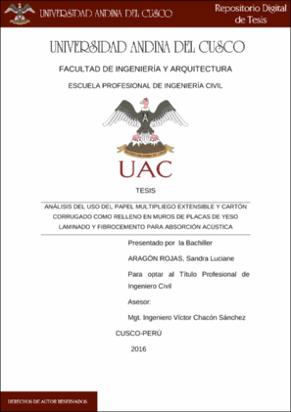| dc.contributor.advisor | Chacón Sánchez, Víctor | |
| dc.contributor.author | Aragón Rojas, Sandra Luciane | |
| dc.date.accessioned | 2017-05-15T16:10:51Z | |
| dc.date.available | 2017-05-15T16:10:51Z | |
| dc.date.issued | 2016-12-15 | |
| dc.identifier.uri | https://hdl.handle.net/20.500.12557/700 | |
| dc.description.abstract | La finalidad de esta Tesis fue determinar los porcentajes de Absorción Acústica
de tres muros distintos.
Se construyó un muro de Placa de Fibrocemento y Yeso Laminado de 0.30 m de largo, 0.15 m de ancho y 5.8 cm de espesor, con una estructura interna de aluminio. Antes de iniciar el proceso de relleno, se calculó el coeficiente de Absorción Acústica de todos los materiales con un Sonómetro, y una fuente emisora de sonido a una sola frecuencia de 686.9 Hz. Se cortaron las placas de Fibrocemento de 0.7 cm de espesor, Yeso Laminado de 1.2 cm de espesor y Cartón Corrugado de 0.4 cm de espesor a 0.30 m de largo por 0.15 m de ancho; a su vez se generó diferentes espesores a partir de una placa, pegando después las demás hasta llegar a espesores de diez de ellas. Para el Papel multipliego.
Extensible arrugado de tres pliegos los espesores variaron desde dos hasta diez cm; cortando estos a un aproximado de la cuarta parte de las bolsas originales.
Se eligió un espesor de ambos materiales como relleno del muro originalmente
construido y se procedió a tomar datos con un sonómetro para observar el porcentaje de Absorción Acústica de cada uno de los tres muros mencionados
inicialmente.
En esta investigación se realizaron un aproximado de 1400 pruebas; obteniendo los siguientes resultados: El muro relleno con Cartón Corrugado presentó 25% de Absorción Acústica respecto al muro relleno con Papel Multipliego Extensible y el muro sin relleno, siendo sus resultados 24% y 22% de Absorción Acústica respectivamente. En cuanto al coeficiente de Absorción acústica se obtuvo que el Papel Multipliego Extensible y Cartón Corrugado presentan una relación creciente con respecto al espesor de los materiales a diferencia de las Placas de Fibrocemento y Yeso Laminado que mostraron una relación creciente y decreciente a medida que se incrementaba el espesor de las placas. Los promedios de los coeficientes de Absorción Acústica respecto a los espesores de los materiales fueron: 0.25 para el Yeso Laminado, 0.25 para el Papel Multipliego Extensible, 0.23 para Cartón Corrugado y 0.22 para el Fibrocemento. | es_PE |
| dc.description.abstract | The purpose of this thesis was to determine the percentages of Acoustic Absorption of three different walls.
A 0.30 m long, 0.15 m wide and 5.8 cm thick Fibrocement and Laminated Gypsum Wall was built with an internal aluminum structure. Before starting the filling process, the Acoustic Absorption coefficient of all materials was calculated with a Sound Level Meter, and a sound source at a single frequency of 686.9 Hz.
Fibrocement plates of 0.7 cm thickness, Gypsum Laminate of 1.6 cm of thickness and Corrugated Cardboard of 0.4 cm of thickness to 0.30 m of length by 0.15 m of width; In turn different thicknesses were generated from one plate, then the others were glued to thicknesses of 10 of them. For the Multi-sheet wrinkled Extensible Paper of three layers the thicknesses varied from two to ten cm; cutting these to an approximate one fourth of the original bags. A thickness of both materials was chosen as a filler from the wall originally constructed and data were taken with a sound level meter to observe the percentage of Acoustic
Absorption of each of the three walls mentioned initially.
In this investigation, approximately 1400 tests took place; with the following results: The wall filled with Corrugated Cardboard presented 25% of Acoustic Absorption in relation to the wall filled with Multi-sheet wrinkled Extensible Paper and the wall without filling which had a 24% and 22% of Acoustic Absorption respectively. Regarding the Acoustic Absorption coefficient, it was obtained that the Multi-sheet wrinkled Extensible Paper and Corrugated Cardboard presented an increasing relation with respect to the thickness of the materials unlike the Plates of Fibrocement and laminated Plaster that showed an increasing and decreasing relation as we increased the thickness of the plates. The averages Acoustic Absorption coefficients with respect to material thicknesses were: 0.25 for Laminated Gypsum, 0.25 for Multi-sheet wrinkled Extensible Paper, 0.23 for Corrugated Cardboard and 0.22 for Fibrocement. | en_US |
| dc.description.uri | Tesis | es_PE |
| dc.format | application/pdf | es_PE |
| dc.language.iso | spa | es_PE |
| dc.publisher | Universidad Andina del Cusco | es_PE |
| dc.rights | info:eu-repo/semantics/openAccess | es_PE |
| dc.rights.uri | https://creativecommons.org/licenses/by-nc-nd/2.5/pe/ | es_PE |
| dc.source | Universidad Andina del Cusco | es_PE |
| dc.source | Repositorio Institucional - UAC | es_PE |
| dc.subject | Absorción acústica | es_PE |
| dc.subject | Coeficiente | es_PE |
| dc.subject | Sonómetro | es_PE |
| dc.subject | Papel | es_PE |
| dc.subject | Cartón | es_PE |
| dc.title | Análisis del uso del papel multipliego extensible y cartón corrugado como relleno en muros de placas de yeso laminado y fibrocemento para absorción acústica. | es_PE |
| dc.type | info:eu-repo/semantics/bachelorThesis | es_PE |
| thesis.degree.name | Ingeniero Civil | es_PE |
| thesis.degree.grantor | Universidad Andina del Cusco. Facultad de Ingeniería y Arquitectura | es_PE |
| thesis.degree.level | Titulo Profesional | es_PE |
| thesis.degree.discipline | Ingeniería Civil | es_PE |


